| This
page weaves together excerpts from a number of accounts of the making
of Genevieve. To read about the production of Genevieve from
the perspective of The Veteran Car Club, read Elizabeth Nagle's account of the
Club's dealings with the producers
here. |
| Following
text
from Quentin Falk's "The Golden Gong: Fifty Years Of The Rank Organisation,
Its Films And Its Stars" © Columbus Books 1987; (currently out of print).
Stills courtesy BFI Films: Stills Posters and Designs |
| Quentin
Falk: Motorists
negotiating country lanes near Moor Park Golf Club in Hertfordshire, north
of London, must have been astonished suddenly to find signposts proclaiming
"Brighton: 6 miles." A local copper was positively bewildered when,
glancing out of his bedroom window one morning, he saw another sign,
"Beware: Cattle Crossing," which seemed to have sprung up mysteriously
overnight. It was in the gathering winter of 1952-3, and one of Rank's most
successful, and enduring, films had begun shooting. |
| That
Genevieve even made it before the cameras was a triumph for the
persistent 39-year-old producer-director
Henry
Cornelius. South African-born and
Sorbonne-educated, "Corny," as he was known, first learned his craft
as an assistant to the great French director René Clair. As director, he met
had made the popular Ealing comedy Passport to Pimlico (1949). Following
text
from Sir Michael Balcon's "Michael Balcon presents... A Lifetime of Films"
©
Hutchinson & Co., 1969
(currently out of print).
|
|
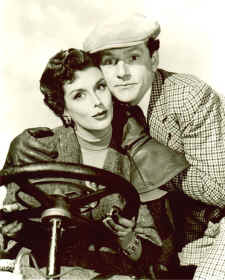 |
|
|
|
|
|
Sir Michael Balcon:
Henry Cornelius had left Ealing and set himself up as an independent.
After much frustration he managed to get financial support for a film,
The Galloping Major, a good comedy idea of a small community investing
in a racehorse.
It made an appealing film but,
inappropriately for a racehorse, it was a bit of a slow starter and
consequently Corny had difficulty in setting up his second film. Pocketing
his pride, he returned to me with an outline story, by no means fully
developed, by Bill Rose, and I knew at once that it could not miss.
I was now faced with a moral dilemma. Our own schedule of
films of was arranged and if I took Corny back it would mean displacing another
director, an idea which would not have proved popular for good and valid
reasons. Although Corny was immensely popular with his ex-colleagues at Ealing,
he had left of his own volition and, by the way, it was very rare for anybody to
leave Ealing.
As I was then a director of The Rank Organisation, I sent
Corny to Earl St. John, in charge of production at Pinewood. |
|
|
|
|
|
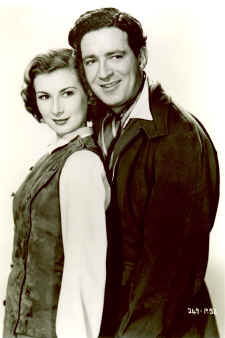 |
Quentin
Falk: Armed
with the script by William
Rose, an American, Corny went out to persuade Earl St. John to back the film on behalf of Rank. St. John,
confronted with this whimsical comedy about two young couples who plan to race
their old crocks home from the London-Brighton veteran car rally, was
incredulous. "If we made that sort of film, I'd get the sack and, frankly,
I can't afford to lose my job," he told Corny. But
the filmmaker just would not take "no" for an answer and returned two or three
more times to work on St. John. Finally
the Organisation's executive producer asked what the budget would be. The answer
was £115,000 -- not a vast amount, he admitted, but he'd still have to get
board approval. |
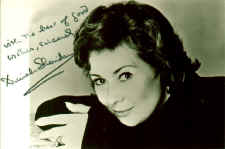 Rank
eventually agreed to provide 70 percent of the investment as long as Cornelius
could find the remaining 30 percent, which he managed thanks to the involvement
of the government-sponsored "merchant bank," the National Film Finance
Corporation (NFFC). Rank
eventually agreed to provide 70 percent of the investment as long as Cornelius
could find the remaining 30 percent, which he managed thanks to the involvement
of the government-sponsored "merchant bank," the National Film Finance
Corporation (NFFC).Following
text
from Christopher Challis's "Are They Really So Awful? : A Cameraman's
Chronicle" © Christopher Challis 1995. This book is
available at Amazon and is highly recommended.
and is highly recommended. |
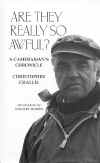 Christopher
Challis: ...The
Rank Organisation agreed to back it, but with the minimum investment, and on
condition that Henry Cornelius put up the completion money himself. In order to
do this, he had mortgaged his house and sold every tangible asset and here he
was, with the absolutely minimum of finance, on the verge of turning his dream
into a reality. Christopher
Challis: ...The
Rank Organisation agreed to back it, but with the minimum investment, and on
condition that Henry Cornelius put up the completion money himself. In order to
do this, he had mortgaged his house and sold every tangible asset and here he
was, with the absolutely minimum of finance, on the verge of turning his dream
into a reality. |
|
 |
|
|
|
|
|
| Quentin
Falk:
Casting
was to prove perhaps the key to the film's eventual success. Playing Alan and
Wendy McKim were to be John Gregson, who had already featured in some Ealing
comedies, and Dinah Sheridan, the English rose of Where
No Vultures Fly (1951). |
|
|
|
|
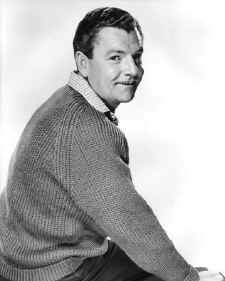 Kenneth
More was, at the time, wowing West End theater audiences in Terrence Rattigan's The
Deep Blue Sea.
"Critics hailed me almost as an overnight discovery," he
reflected, "conveniently forgetting I was already 38 and I'd been working
in the theater for nearly twenty years." More had also been seen in a
handful of small screen roles, including Scott of the Antarctic (1948). Kenneth
More was, at the time, wowing West End theater audiences in Terrence Rattigan's The
Deep Blue Sea.
"Critics hailed me almost as an overnight discovery," he
reflected, "conveniently forgetting I was already 38 and I'd been working
in the theater for nearly twenty years." More had also been seen in a
handful of small screen roles, including Scott of the Antarctic (1948).Following
text
from Kenneth More's "Happy Go Lucky" ©
Kenneth More 1959, Robert Hale Ltd.
(currently out of print). Mr.
More is a wonderful storyteller, but his versions of events are often at odds
with the recollections of others.
Kenneth More:
One evening after the performance of The Deep Blue Sea, I was in my
dressing room at the Duchess when a message came up from the stage door that Mr.
Cornelius wanted to see me. |
|
|
|
|
|
|
 "Cornelius?" I asked. "Cornelius?" I asked.
"Yes.
Henry Cornelius."
The name meant nothing to me. Suddenly I remembered; he had
directed that test for Scott of The Antarctic at Ealing.
[Quentin Falk
points out that
More had played a "spit and a cough" in the director's The
Galloping Major a year earlier, so it seems highly unlikely that the name
Henry Cornelius would "mean nothing" to More!]
Corny came up. Born in South Africa and educated in Germany and France, he
was the enfant terrible of the film world of pre-Hitler Berlin. He
worked on The Drum and The Four Feathers as film editor, and
since our last meeting had directed the top Ealing comedy Passport to
Pimlico. Now he had formed his own
independent company.
|
|
|
|
|
|
In The Deep Blue Sea we had won such ecstatic reviews, and flattery
from visitors had become such a routine thing, that I fully expected him
to say: "What wonderful performance tonight!" But when I asked him if he had been out front, he said:
"No."
"You've seen the play already then?"
"As a matter-of-fact I haven't. This sort of show isn't
my cup of tea at all."
I was at a loss. I couldn't help asking: "What is it you
want?"
"I'd like you to be in a film I'm making," he said.
"The test you did for Scott showed me that you have the qualities I
need."
He
went on to explain that he had been offered the outline of a story which he
liked so much that he snapped it up within 48 hours. "The plot," said
Corny, "centers on the veteran cars annual rally from London to
Brighton."
"What do you want me to play?" I asked.
"Ambrose Claverhouse -- brash, bouncy, girl-chasing; an
extrovert."
"Comedy?"
"Character comedy."
|
|
|
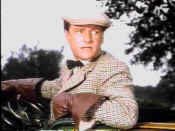 |
|
Ambrose, Corny said, is an advertising agent who rides in
ancient barrel-bonneted Dutch Spyker in the rally. His intentions where women
are concerned are far from honourable. He believes in taking a different girl
with him on every week-end trip. On this occasion his companion is a model,
Rosalind Peters. Ambrose also has a friend, a young barrister named Alan McKim,
who goes to Brighton with his wife Wendy in "Genevieve," a 12
horsepower Darracq made in Paris in 1904. All
four get to Brighton, but Ambrose and Alan quarrel, the outcome being a 100
pound wager as to which of them can drive back to Westminster Bridge first.
|
|
|
|
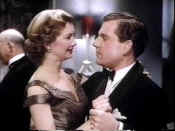 |
|
|
|
|
|
| "The return journey," Corny enthused, his eyes
sparkling, "is packed with laughs; water splashes, sheep blocking the road,
children holding up the cars by dawdling on the zebra crossing, and so on.
Ambrose and Alan practically go crazy with excitement." [Dinah
Sheridan says
the children on the zebra crossing was a last-minute inspiration on the part of
Henry Cornelius.]
He
gave me the script. I put it on my knee, glanced at the title -- Genevieve
-- and started reading.
|
|
|
|
|
"We'll be doing it in Technicolor at Pinewood,"
Corny went on, persuasively. "Larry Adler is composing the music."
I hadn't finished the second page before I realized that the
film was for me. "This is marvelous," I said. "I've got to be in
it!"
"Of course," said Corny. "And you will
be too. I'm a very determined man. The part has been written with you in mind."
[Dinah
Sheridan says
the director's first choice for the part was Guy Middleton]
Then I started to think of the obstacles, all the difficulties
that would crop up. "I've just been married," I said. "We're
moving house at any moment and I'm appearing in this play!"
|
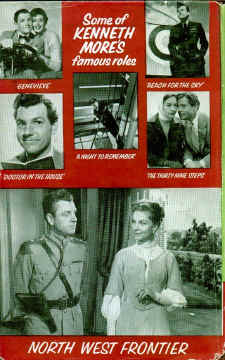 |
|
|
|
|
But every objection I raised, Corny knocked down.
Moving house? The best removal firm in London would be called
in; it would lay on a fleet of vans and we wouldn't have to lift a finger.
Getting from the studio to the theater? He would personally arrange for a
superfast car to do the journey at record speed.
"But what about [More's wife] Bill?" I asked.
"How will she manage on her own? I won't have time to see anything of her
at all if I do a film as well as a play."
"Don't worry," said Corny blandly. "She can
visit you at the studio. We serve lovely meals in the canteen."
Lovely meals in the canteen!
"Anyway," said Corny, "come and have lunch
tomorrow with me and Kay Kendall. She is to be your girlfriend, Rosalind, in the
film".
|
| |
|
|
|
|
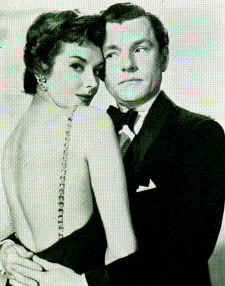 |
"Quentin
Falk: The vivacious Kay Kendall
(born Justine McCarthy), though only 26, had made an earlier bid for
stardom in the film London Town.
Kenneth More:
As
far as Katie was concerned, it was to be her second bid for stardom. Once the
youngest-ever member of the Palladium chorus line,
she starred at the age of 17
in London Town, perhaps the biggest screen flop of all time. She had
seemed set for a golden career; then suddenly everything was finished. It was
the most shattering experience anyone could have. But she had guts; she went
into rep, did TV and gradually charmed her way back into the films.
|
|
|
|
|
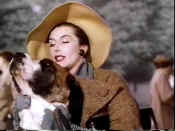 The three of us met in Rule's, in Maiden Lane, for the maddest
lunch I can remember. Corny opened his briefcase and brought out sheets and
sheets of foolscap on our "family backgrounds." I, as Ambrose, was the
son of a kidney pill manufacturer; Katie learned that Rosalind's grandfather had
crossed the Alps at the age of three. The three of us met in Rule's, in Maiden Lane, for the maddest
lunch I can remember. Corny opened his briefcase and brought out sheets and
sheets of foolscap on our "family backgrounds." I, as Ambrose, was the
son of a kidney pill manufacturer; Katie learned that Rosalind's grandfather had
crossed the Alps at the age of three.
We roared with laughter. We were in fits.
"What on earth does it matter who our relatives
were?" we asked. "Either you want us to play these parts or you
don't!"
 But Corny didn't work like that. He was very painstaking. He
believed in what I suppose could be called The Method. But Corny didn't work like that. He was very painstaking. He
believed in what I suppose could be called The Method.
We must have had one glass too many of the burgundy because
Katie and I ended the meal by promising to do the film.
For me, Genevieve was a bid for stardom too. I
remembered what Bill had told me once, when I confided in her my hopes for the
future.
"You'll never be a star," she said, "until
you've had a part with real personality in it."
Was Ambrose Claverhouse, the hearty terror of the highways,
the answer?
I signed a contract with Corny for £2,500.
The
snag that probably none of us fully realized when we entered the film so gaily
was that three-quarters of the shooting was on outdoor location. The 57 day
production schedule lasted from October to February, right through some of the
bitterest weather of the year.
Christopher Challis:
George Gunn [a Technicolor
representative] had persuaded Henry that, in spite of the money problem, the
extra cost of filming in colour was more than worthwhile as, at that time, it
was still a great attraction at the box office.
|
|

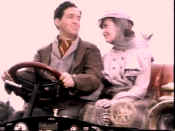
|
Planned to be filmed
almost entirely outdoors... weather was obviously a big hazard and Henry
explained that he could not afford to wait for ideal conditions. 'If there
is enough light to get a bare exposure, I just have to shoot. I know it's
asking a lot, but there is no other way I can make the picture.' Kenneth More:
Corny very cunningly solved
the lighting problem by taking his own special brand of sunshine with us
in the form of a generator and 24 arc lamps. The result was a fantastic
sight. A winding caravan of cars, vans and trucks loaded with 50 tons of
gear blocked the roads and caused traffic chaos. |
|
|
|
|
Christopher Challis:
The traveling scenes in the cars
were resolved by loading the whole unit into in large flat, open trailer,
known as a 'Queen Mary.' It was a relic of the war and had been used to
transport military aircraft. We all piled in - camera, lights, crew and
small generator -- and on the back was perched a mock-up of the car in
which our actors 'drove.' |
|
|
|
|
The whole circus was
at the mercy of the driver in the cab of the Queen Mary, who often proved
difficult to communicate with. Another truck followed with mock-ups of the
other cars, ready to be switched at a moment's notice. For forward-looking
shots, another flat truck was used. The driving cab was removed, further
mock-ups made to disguise what little we saw of the bonnet and a period
steering wheel and windscreen fitted, all of which had to be changed each
time we switched cars.
|
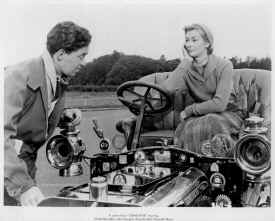 |
| |
|
| Kenneth More:
The genuine London to Brighton route wasn't right for all the
backgrounds we needed so, on the assumption (later proved correct) that only
diehard devotes of the rally would notice, we shot quite a few of the "deep
in the heart of Sussex" scenes in Buckinghamshire, near Moor Park golf
course. When we did venture into Sussex, we littered it with phony
signposts, signs and traffic lights. Motorists were baffled to see
"Brighton 6" on signposts when they thought that the sea was at least
40 miles away. |
|
|
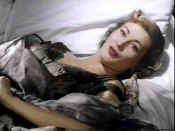 |
We
had a high-spirited time together. Playing Wendy McKim was Dinah Sheridan, the
blue-eyed strawberry blonde who is a keen, hearty motorist. She took a
bone-rattling on African roads in Where No Vultures Fly, but had to admit
that bumping down a cart-track in Kenya in a jeep was paradise compared with the
trip to Brighton in Genevieve. |
| |
|
| Then, of course, there was Katie, who loves fun and laughter.
She lounged around the set, a dazzling vision in tight blue jeans and mules
trimmed with ostrich feathers. For the actual film, Marjorie Cornelius, Corny's
wife, designed for her some superb creations, very elegant, very English, with
enormous floppy hats. |
| |
|
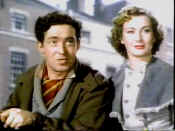 |
Marjorie's costumes for Dinah, I recall, included a dress in
chocolate, coffee and strawberry, which gave the appearance of a very delectable
Neapolitan ice.
My rival in the film, in our grueling, jolting journey was
John Gregson, a burly, tousle-haired Liverpudlian who like myself was in the
Royal Navy during the war, but in minesweepers.
|
| |
|
|
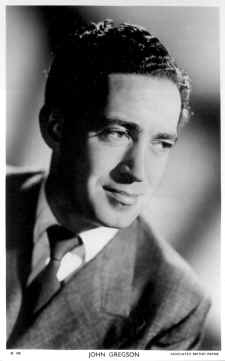 |
Also like me, he had been in that frosty epic, Scott of the Antarctic, though he had taken a shortcut
to success with Whiskey Galore, The Lavender Hill Mob and Angels
One Five. In Genevieve, John achieved the no mean feat of driving
from London to Brighton and back without a full driving license! He took a
course of lessons, but there wasn't time to pass his test before filming began.
In all, he did about 100 miles at the wheel, with the police turning of the
blindest of the blind eyes.
In many respects we enjoyed
ourselves immensely. |
|
|
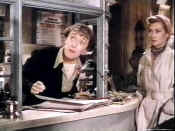 We had Joyce Grenfell giving an
excruciatingly genteel performance as a hotel manageress. Also, John got a taste
of the penalties of screen fame when audiences believe implicitly in what you
do. We had Joyce Grenfell giving an
excruciatingly genteel performance as a hotel manageress. Also, John got a taste
of the penalties of screen fame when audiences believe implicitly in what you
do.
We were in the Old Kent Road, waiting between takes, when a
little girl of about nine came up and asked him: "Hey, mister, is your name
John Gregson?" |
|
|
John preened himself, admitted that he was indeed John Gregson
and prepared to whip out his fountain pen for an autograph. But little girl
hadn't finished her questions.
"Weren't you in Venetian Bird?"
John nodded.
"And didn't you bash Richard Todd on the back of the
head?"
"Well, yes," John admitted. "That's
right."
|
|
|
"Then I'll never see one of your pictures again as long
as I live!" With that, she swept off.
We had another moment of humour, completely unrehearsed and
certainly not in the script, which all happened because Corny was such a
perfectionist. He had to have everything right. Every single scene had to be
filmed time and time again, just to be absolutely sure.
|
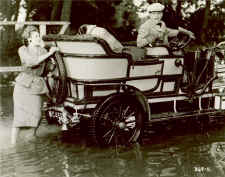 |
| |
|
This wasn't too bad in the studio, but it was perfect hell out
of doors. One morning -- about 7:00 it was, and dreadfully cold -- Kate and I
had to do a shot in which we drove down the road towards the camera.
We
did it once, but Corny wasn't satisfied. We did it again, but that wasn't right;
a hair had got in the gate of the camera. We did it a third time -- and a
fourth. On each occasion, the repeat performance meant driving half a mile back
up the road again and turning round.
The weather grew even worse. A fine penetrating drizzle came
down, soaking us through. We couldn't wear macs or any other kind of protection
because it was supposed to be fine weather.
The more times we kept on doing the journey, the more frozen
and cross Katie became. When we had done the scene for the fifth time, and Corny
said: "Let's have just one more!" Katie grabbed the parasol which was
in a long wicker basket running down the side of the car. Holding the parasol
both hands, she started to whack Corny over the head with it.
"You're a rotten little so-and-so!" She screamed.
"You're a miserable, dried up little man!"
[Dinah
Sheridan says
that she was actually the one on the receiving end of Kay Kendall's outburst]
I thought she was joking. It was colossal fun seeing Corny
being brained. I roared my head off.
But it was no joke. It was genuine. Katie had really gone. She
was hysterical. The terrible cold weather, added to the normal tension of
filming, had got her down.
I shouldn't have laughed. In a few more days I was feeling the
same way myself.
|
|
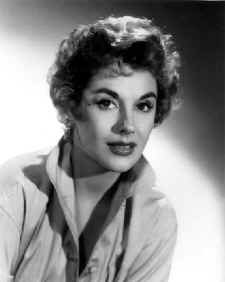 |
Quentin
Falk: Olive Dodds, the Organisation's director of artists and regular confidante of her
charges, said that Kay Kendall spent hours with her "trying to persuade me
to get her out of the film, which they all thought, while shooting on it, would
be a disaster. The combination of the long filming, the many takes, changes in
script and very, very bad weather had put them all into the glooms. In my
view, it proved to be the one part that appeared to have been written for Kay
and Kay alone.
Following text from Eve Golden and Kim Kendall's
's "The
Brief, Madcap Life of Kay Kendall" ©
2002 The University Press of Kentucky. Finally, the
real story behind Kay Kendall's behavior during the
filming of Genevieve." |
Eve Golden and Kim
Kendall:
Kay
had more problems than Kenneth More realized: she had found out a week
or two into filming that she was pregnant. Kay took three days off [in
order to end the pregnancy] and came back to work much sooner than she
should have. Weak and anemic under the best of circumstances, she was in
no shape to withstand jostling in antique cars and sitting about in the
freezing cold. "She was really in a bad way," recalls Dinah Sheridan.
"She shouldn't have been back at all." |
| |
|
| Kenneth More:
Seven-eighths of the way through Genevieve we ran out of
money. In order for work to begin on a film these days, the financial
backing for it, known as the "guaranteed completion money," has to be put
up first. |
| |
|
|
If for any reason the producer goes
over his budget, more money is needed to finish the job. This might mean 20,000
pounds or more. Insurance companies, however, give protection against this, and
for a premium they will, if the worst happens, step in and help the producer by
supplying "end money," as it's called. They're on a pretty good wicket, I think,
and don't have to pay out very often.
An exception, though, was Corny. He always ran over. He
went on and on, persevering until he got what he believed was right. He never
compromised. He never cut anything out. He never shortened anything.
Eventually with Genevieve, we reached a stage where the
insurance company was financing us. It didn't like paying out. To save a bit
here and save a bit there, it had little men prowling around the studio,
switching off lights that weren't needed. During the final weeks shooting they
watched electricity meters like hawks. It was as bad as having the bailiffs in.
|
| |
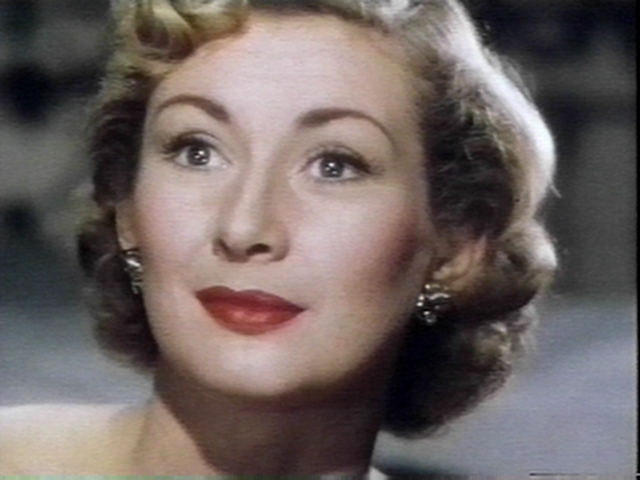 Dinah Sheridan: In
February of 1953, we saw loops of the film in a darkened studio and had to
repeat our dialogue into a microphone. We each re-recorded our lines separately
- we weren't together. We had a reference tape recording that had been made
throughout the filming. When you re-recorded a line, you had to match the
original as closely as possible -- and we were out-of-doors; we were sniffing,
we were coughing... choking, probably -- and we had to do it exactly as it had
been. That wasn't easy at all. 80 to 85% of the dialogue in the film had to be
recreated on the soundstage. Dinah Sheridan: In
February of 1953, we saw loops of the film in a darkened studio and had to
repeat our dialogue into a microphone. We each re-recorded our lines separately
- we weren't together. We had a reference tape recording that had been made
throughout the filming. When you re-recorded a line, you had to match the
original as closely as possible -- and we were out-of-doors; we were sniffing,
we were coughing... choking, probably -- and we had to do it exactly as it had
been. That wasn't easy at all. 80 to 85% of the dialogue in the film had to be
recreated on the soundstage.
|
|
I was at home one day and they
telephoned and said, "We've got Kay here, doing her lines... and she can't
laugh. She is quite incapable of producing a natural hysterical laugh. Could you
come over to the studio and help her?" Much to my delight, I got an extra
day's pay to go over to Pinewood Studios - about a fifty-minute drive - and
produce, with Kay, hysterical laughter. Then I had to stop, and she had to go
on.
In the scene in the Brighton hotel
room, the loud argument between Alan and Wendy provokes an awful banging on the
wall from the very annoyed people next door. The sound of this banging was added
later. When they filmed the scene, I had to react to nothing. All I knew was
that it was in the script. Alan leaves for the garage; the banging starts up on
the wall again, and I take a brown paper bag, blow it up, and explode it onto
the wall. And then there's a scream from the other side of the wall --
obviously, I'd stopped the banging. What few people know is that during the
re-recording sessions, they asked me to perform the scream! So that's me
you're hearing from the other side!
|
| |
|
The film starts practically silent - you get no music at all right through
the first credit titles - then Larry Adler's music begins. |
Click the button above to hear Larry
Adler's "Theme From Genevieve" |
|
|
|
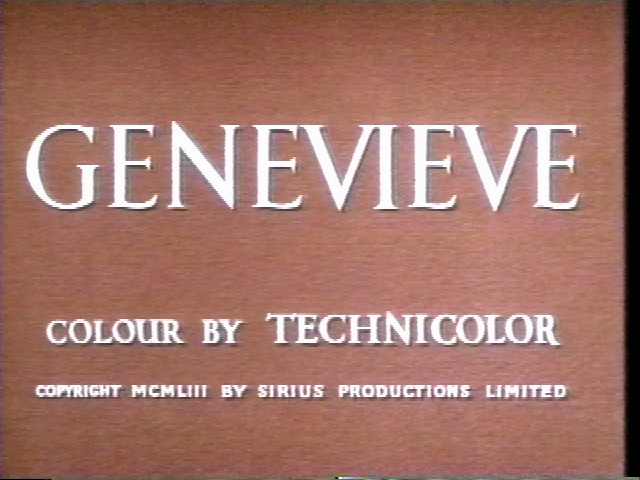 |
Wonderful,
simply marvelous music. Larry told me many years afterward (I didn't meet
him until many years afterward) how he was given the script and was asked
if he'd write the music. And he said yes, he would love to. He had got an
idea for it and he would absolutely love to. And they said, "How much do
you want?" And Larry named a price, and they said, 'But we've told you, we
don't have any money, we just want you to do the film." |
| |
|
|
And Larry said, yes, he'd love to do it, too, but he couldn't do it for nothing.
And so he lowered his price quite a bit. And they said, "Now, look, we said
we don't have any money!" And he said, oh dear, I really want to do
this, and I've got such a good idea for it... I'll do it for a two-and-a-half
percent interest in the film. Which made him the only one -- except for Henry
Cornelius and the Rank Organisation -- who got anything out of it at all. We got
2,500 pounds, and that was it - we've never had another penny. But Larry still
gets two-and-a-half percent!
Quentin
Falk:
As
if confirming the worst -- apparently, the "front office" didn't like
the finished film -- the opening at the Odeon, Leicester Square was, according
to Keith Robertson of Rank Film Distributors (now RFD's director of
administration), then still General Film Distributors, "a non-event."
It
was, at first, very coolly received.
|

It often happens that winners are not recognized as such at
first by the people close to them. Bill Rose tells of the day when he and Corny
were in the bar at Pinewood, anxiously awaiting the verdict of the "front
office" after the first showing. Earl St. John came in, put his arms around
their shoulders and said in the nicest possible way -- and he was, indeed, a
very kindly man -- something to the effect that they were not to be depressed;
he believed in them and they would surely make a good film sooner or laterChristopher
Challis:
The first showing of the completed film was in the preview theatre at
Technicolor. As the lights came up at the end, Earl St. John, the American head
of production, who had expressed little interest in the film during its making,
rose to his feet and observed to Henry, and the rest of us who made the movie,
'We may get a few car nuts to go along and see it in this country, but it won't
do business anywhere else.'
|
| |
|
Quentin
Falk:
But somehow, with the word-of-mouth, it
took off and the results were amazing. In those days it took about 18 months for
a film to go through the sequence of six-day bookings, three-day bookings,
Sunday nights...
"We
didn't let Genevieve go to Sunday nights, we put it out as a reissue
double bill with our other big hit, Doctor in the House. We'd always had
double feature programs, but it was always a first feature and a B-picture. This
was the first of its kind -- "the Doc and the Crock" -- and it proved
to be one of the most successful double programs we've ever put on."
Full
of now-classic moments like Kay Kendall's impromptu trumpet solo, the creaking
bed rocked by the chimes of the huge clock opposite, and More telling Kay to get out and
push the recalcitrant Spyker, not to mention
wonderful cameos by Geoffrey Keen as a traffic policeman and Joyce Grenfell as a
hotel proprietress, plus Larry Adler's fine harmonica score, no wonder Genevieve
was named Best British Film of 1953. It also, perhaps surprisingly for something
so quintessentially English, earned two Oscar nominations, for William Rose's
deft screenplay and Muir Matheson's music direction.
|
|
|
 Sadly,
only one of the starring quartet is still alive today: Dinah
Sheridan. Kay
Kendall died in 1959 (a year after Henry Cornelius), John Gregson in 1975 and
Kenneth More in 1982. Sadly,
only one of the starring quartet is still alive today: Dinah
Sheridan. Kay
Kendall died in 1959 (a year after Henry Cornelius), John Gregson in 1975 and
Kenneth More in 1982.
As
Miss Sheridan reflected: "It's very sad. I'm very much the lone
survivor -- if you don't count Genevieve herself. She will be our epitaph."
Sir
Michael Balcon: Despite the variety of films we made over the years, I suppose
it is the comedies with which Ealing will always be identified. Even as late as
1967, an American correspondent of The Times, commenting on a letter from
a number of American governors, senators, congressman, chancellors of
universities, etc., on means of preserving the historic relationship between
[the United Kingdom and United States], said: "the old Ealing studio
comedies, which are still appearing on television late-night shows, have done
more for the relationship than any official program could have done."
|
| |
|
Corny and the enchanting Kay Kendall are, alas, dead long
before their time but Genevieve will remain in the hearts of all the fans
of their generation. Meanwhile Bill Rose, now a naturalized British subject, has
done a lot of work for Hollywood and has among his more recent credits such
important script as It's a Mad, Mad, Mad, Mad World and Guess Who's
Coming to Dinner?, for which he deservedly won an Oscar, for the best
original screenplay, in 1968.
|
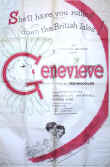 Genevieve was perhaps the most successful British comedy film ever
made -- written by an Ealing man and directed by another, but, alas, not at
Ealing! Genevieve was perhaps the most successful British comedy film ever
made -- written by an Ealing man and directed by another, but, alas, not at
Ealing!
One of the world's great
movies; one of the world's worst one-sheets: the American poster for
"Genevieve."
|
| |
|
[ Up ] [ Genevieve Rally July 2002 ] [ Models and More ] [ Bookshelf ] [ Genevieve Links ] [ Is This the Real Mr. McKim? ] [ What's Wrong Here? ] [ The 'Very Easy' Genevieve 50 Years On Quiz ] [ Genevieve Picture Gallery ] [ Music by Larry Adler ] [ Genevieve's History ] [ The Cast ] [ Filming Locations ] [ Making "Genevieve" ] [ London to Brighton 2000 ] [ Audio Clips ] [ Site Map ] [ Thanks ] [ Down Under ] |
|
